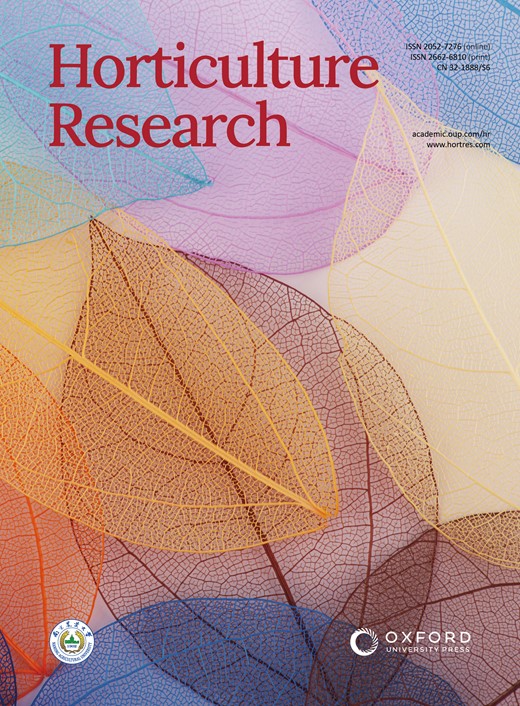阐明金茶花黄酮醇生物合成的关键途径及其在番茄果实代谢基因改造中的应用
IF 8.7
1区 农林科学
Q1 Agricultural and Biological Sciences
引用次数: 0
摘要
金茶花是指山茶花属中花瓣呈黄色的一组物种。这些花瓣中的次生代谢物具有观赏价值和潜在的保健作用。然而,金花瓣中合成这些代谢物的生物合成机制仍然难以捉摸,其生物活性成分的开发利用也尚未完全实现。这项研究收集并分析了 23 种金花茶,发现黄酮醇类化合物,尤其是槲皮素 3-O 葡萄糖苷和槲皮素 7-O 葡萄糖苷,是金花色素沉着的主要成分。综合转录组学和共表达网络分析发现,CnFLS1 是生物合成途径中的一个关键基因,它与 CnCHS、CnF3'H 和 CnUFGT 共同协调了花色形成的特定途径。酶测定显示,CnFLS1对DHQ具有很高的亲和力和催化效率,在烟草中瞬时表达CnFLS1可提高槲皮素黄酮醇的生物合成,这突出了金花茶的途径特异性。此外,用各种生物合成基因对栽培番茄进行策略性转化,获得了果实呈黄色、果肉富含槲皮素的转基因品系。这些经过改造的品系不仅含有金花茶特有的黄酮醇成分,而且抗氧化能力和抗逆性也明显提高。这项研究的成果不仅阐明了金茶花色素沉着的代谢过程,还为通过合成生物学技术开发新型番茄品种奠定了基础。本文章由计算机程序翻译,如有差异,请以英文原文为准。
Elucidation of the key pathway for flavonol biosynthesis in golden Camellia and its application in genetic modification of tomato fruit metabolism
Golden Camellia refers to a group of species in the genus Camellia that display yellow petals. The secondary metabolites in these petals hold ornamental significance and potential health benefits. However, the biosynthetic mechanisms governing the synthesis of these metabolites in golden petals remain elusive, and the exploitation of their bioactive components is not fully realized. This research involved the collection and analysis of 23 species of golden Camellia, leading to the discovery that flavonols, particularly quercetin 3-O-glucoside and quercetin 7-O-glucoside, are the primary contributors to the golden flower pigmentation. Integrative transcriptomics and co-expression network analyses pinpointed CnFLS1 as a crucial gene in the biosynthetic pathway, which, in conjunction with CnCHS, CnF3'H, and CnUFGT, orchestrates the specific pathway for flower color development. The enzyme assays revealed a high affinity and catalytic efficiency of CnFLS1 for DHQ, and transient expression of CnFLS1 in tobacco was shown to enhance the biosynthesis of quercetin flavonols, highlighting the pathway specificity in golden Camellia. Moreover, strategic transformations of cultivated tomatoes with various biosynthetic genes yielded transgenic lines exhibiting yellow fruit and quercetin-enriched flesh. These modified lines not only contained distinct flavonol components characteristic of golden Camellia but also demonstrated markedly improved antioxidant capabilities and enhanced resistance. The outcomes of this study not only elucidate the metabolic processes underlying the pigmentation of golden Camellia flowers but also provide a foundation for the development of novel tomato breeds through synthetic biology.
求助全文
通过发布文献求助,成功后即可免费获取论文全文。
去求助
来源期刊

Horticulture Research
Biochemistry, Genetics and Molecular Biology-Biochemistry
CiteScore
11.20
自引率
6.90%
发文量
367
审稿时长
20 weeks
期刊介绍:
Horticulture Research, an open access journal affiliated with Nanjing Agricultural University, has achieved the prestigious ranking of number one in the Horticulture category of the Journal Citation Reports ™ from Clarivate, 2022. As a leading publication in the field, the journal is dedicated to disseminating original research articles, comprehensive reviews, insightful perspectives, thought-provoking comments, and valuable correspondence articles and letters to the editor. Its scope encompasses all vital aspects of horticultural plants and disciplines, such as biotechnology, breeding, cellular and molecular biology, evolution, genetics, inter-species interactions, physiology, and the origination and domestication of crops.
 求助内容:
求助内容: 应助结果提醒方式:
应助结果提醒方式:


